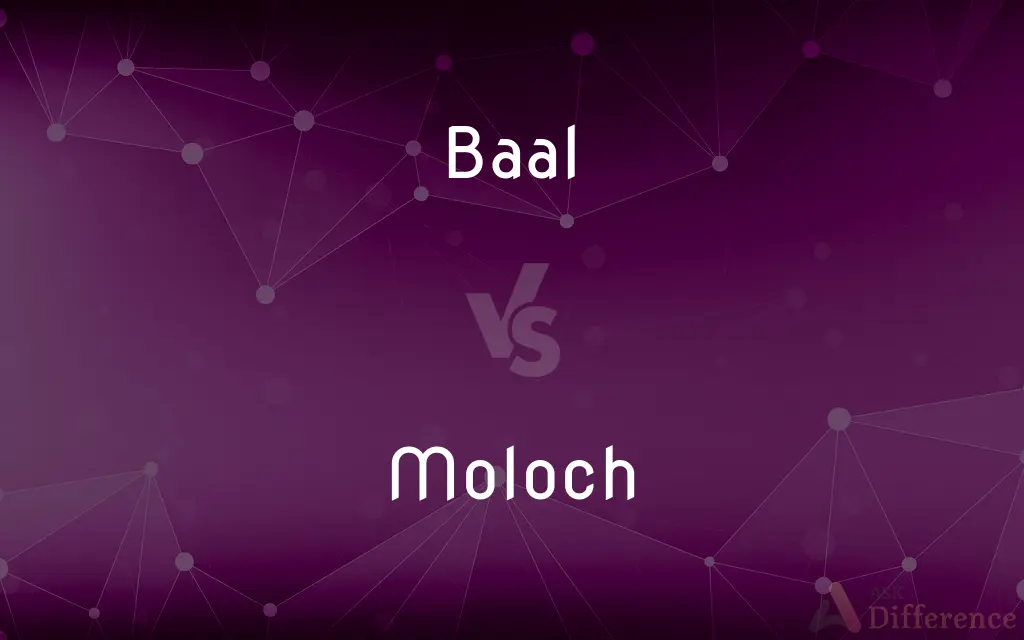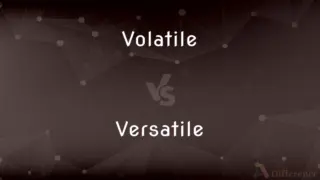Baal vs. Moloch — What's the Difference?
By Fiza Rafique & Maham Liaqat — Updated on February 27, 2024
Baal, a major Northwest Semitic god of rain and fertility, contrasts with Moloch, a god associated with child sacrifice in ancient Near Eastern religions.

Difference Between Baal and Moloch
Table of Contents
ADVERTISEMENT
Key Differences
Baal was worshipped across the ancient Near East, especially among the Canaanites, as a fertility god who controlled rain and harvests. Moloch, on the other hand, is often identified with the practice of child sacrifice, particularly in Carthaginian and Phoenician cultures. This stark contrast highlights the diverse religious practices and beliefs of ancient civilizations.
Baal's worship involved rituals for rain and good harvests, Moloch's worship is infamously noted for its cruel child sacrifices. Such practices for Moloch were seen as a means to gain favor or appease the deity, showing a drastic difference in how divine favor was sought.
Baal is often depicted with a thunderbolt, signifying his power over rain and fertility. Moloch is sometimes represented with a bull's head, symbolizing strength but also the terrifying aspects of his worship. These symbols reflect the nature of each deity and their perceived influence on the world.
Baal is mentioned in various contexts, including the Bible, as a god competing with Yahweh for the devotion of the Israelites. Moloch's mention, particularly in the Bible, is almost always in the context of condemnation for the practice of child sacrifice, highlighting moral and ethical repulsions from neighboring cultures.
Despite their differences, both Baal and Moloch represent aspects of ancient religions that reflect the values, fears, and hopes of their societies. The comparison between Baal’s association with life-giving rain and Moloch's with life-taking sacrifices encapsulates the dichotomy of divine benevolence and malevolence in ancient Near Eastern religions.
ADVERTISEMENT
Comparison Chart
Domain
Rain, fertility, and agriculture
Child sacrifice, possibly also fertility
Worship Centers
Canaan, Phoenicia, and surrounding areas
Phoenicia, Carthage, and associated colonies
Symbols
Thunderbolt, bull
Bull's head, furnace
Worship Practices
Offerings for rain and fertility
Child sacrifices
Cultural Perception
Associated with life and agricultural bounty
Associated with cruelty and condemnation
Compare with Definitions
Baal
Baal was a fertility god responsible for rain and harvest.
Farmers prayed to Baal for abundant rain and a good harvest season.
Moloch
Moloch is sometimes depicted with a bull's head.
Symbols of Moloch often include a bull's head, representing his strength and ferocity.
Baal
Baal’s temples were central to Canaanite religion.
The temple of Baal in Ugarit was a significant religious center.
Moloch
Moloch is often associated with the sacrifice of children.
Devotees offered child sacrifices to Moloch seeking his favor.
Baal
He was a major deity in the Canaanite religion.
Baal was revered across Canaan as a powerful god of life and fertility.
Moloch
Moloch's altars were notorious for their cruelty.
Moloch's altars, according to historical accounts, were scenes of profound tragedy and loss.
Baal
Baal is often depicted holding a thunderbolt.
Ancient artifacts frequently show Baal wielding a thunderbolt, symbolizing his control over storms.
Moloch
He was worshipped by several ancient Near Eastern communities.
Moloch worship was practiced in ancient Carthage as a way to appease the god.
Baal
His worship included rituals and sacrifices.
To honor Baal, followers performed elaborate rituals in hopes of securing his blessings.
Moloch
His worship is condemned in the Hebrew Bible.
The Hebrew Bible explicitly condemns the worship of Moloch and the practice of child sacrifice.
Baal
Baal (), or Baʽal, was a title and honorific meaning "owner", "lord" in the Northwest Semitic languages spoken in the Levant during antiquity. From its use among people, it came to be applied to gods.
Moloch
In the Bible, the god of the Canaanites and Phoenicians to whom children were sacrificed.
Baal
Any of various local fertility and nature gods of the ancient Semitic peoples considered to be false gods by the Hebrews.
Moloch
God of the Ammonites and Phoenicians to whom parents sacrificed their children
Common Curiosities
What symbols are associated with Moloch?
Moloch is often associated with the symbol of a bull's head and sometimes depicted with a furnace for sacrifices.
Where was Baal worshipped?
Baal was worshipped throughout the ancient Near East, notably in Canaan and Phoenicia.
What was Baal the god of?
Baal was primarily the god of rain, fertility, and agriculture in ancient Near Eastern religions.
How was Moloch worshipped?
Moloch was worshipped through the practice of child sacrifice, where children were offered to gain the god's favor or appeasement.
Did Baal and Moloch represent the same aspects?
No, Baal represented fertility and agriculture, while Moloch is associated with child sacrifice and possibly fertility in a more malevolent aspect.
What was the primary difference in worship between Baal and Moloch?
The primary difference was in the nature of their worship; Baal's involved offerings for fertility, while Moloch's included child sacrifices.
Were Baal and Moloch worshipped in the same regions?
Both were worshipped in the ancient Near East, though Moloch's worship is particularly noted in Phoenicia and Carthage.
How are Baal and Moloch depicted in ancient artifacts?
Baal is depicted with symbols of fertility like the thunderbolt, while Moloch is sometimes shown with a bull's head.
Is there any connection between Baal and Moloch in historical texts?
Historical texts, including the Bible, mention both but typically in different contexts, with Baal often linked to fertility and Moloch to child sacrifice.
Why is Moloch often condemned in historical records?
Moloch is condemned for the practice of child sacrifice, which was viewed with moral and ethical repulsion by neighboring cultures.
Share Your Discovery

Previous Comparison
Ionized vs. Unionized
Next Comparison
Volatile vs. VersatileAuthor Spotlight
Written by
Fiza RafiqueFiza Rafique is a skilled content writer at AskDifference.com, where she meticulously refines and enhances written pieces. Drawing from her vast editorial expertise, Fiza ensures clarity, accuracy, and precision in every article. Passionate about language, she continually seeks to elevate the quality of content for readers worldwide.
Co-written by
Maham Liaqat













































